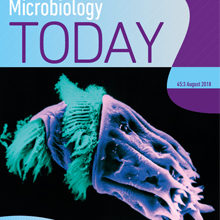Microbiology Today August issue: Microbes and Food
07 August 2018

The August issue of Microbiology Today focuses on the use of microbes and the roles they can play in food. The feature articles reveal a few of the many ways in which micro-organisms impact on food production, digestion, as well as how they can cause and treat disease in the livestock that humans consume.
The first featured article, written by Christine Dodd and Dewi Yunita, explores the numerous ways in which microbes can affect the flavour of the food we eat. The authors discuss the involvement of microbes in the production of fermented products and explain how the metabolites of microbes can have a dramatic effect on flavour, emphasising the changes different species can have on the overall taste of the resulting food product.
Neil McEwan then explores the importance of microbes for herbivores. He explains the ways in which a diverse range of microbial interactions allow these animals to digest the plant material they rely on to survive, while the herbivore digestive tract provides an environment that allows these micro-organisms to thrive.
Next, Richard Harrison and Rob Johnson walk us through the history and production process of QuornTM, the mycoprotein made using Fusarium venenatum. In addition to examining the taste and texture of this product, they look at the impact that the production of this meat alternative has on the planet, compared to meats such as beef and chicken.
Prerna Vohra’s article on foodborne diseases outlines the impact microbes such as Escherichia coli, Campylobacter and Salmonella can have on the health of humans and animals alike. Prerna explores some of the successes sequencing techniques have already had in the research of these diseases, as well as the potential they have for advancing our understanding and treatment of them.
In his article, Robert Atterbury also proposes solutions to the issue of disease in the context of food. He discusses the use of phage as an alternative to the widespread use of antimicrobials in livestock, as one tool in the fight against resistance. He takes us through the history of phage therapy, before looking at how it could be used going forward.
Finally, in his Comment article, Gregor Reid discusses probiotics, answering common questions and dispelling popular myths. While acknowledging that they are not “the silver bullet” he highlights the ways in which using the right probiotics, in the right situations, can provide significant health benefits to people throughout the world.
The issue also contains updates from our journals, prize winners from this year’s Annual Conference, information about upcoming events, outreach activities our members have taken part in and more.
View the latest issue online.
